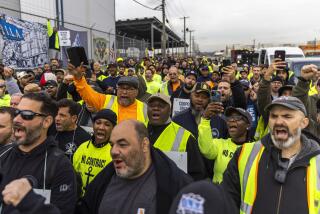L.A. Ports Unclogged but Not in the Clear
The huge floating traffic jam outside Southern California’s ports has cleared, maritime officials said Thursday.
Late in the afternoon, 60 ships were in the process of being unloaded at the ports of Los Angeles and Long Beach. That was down sharply from the peak of 94 vessels that were in the unloading queue Oct. 11, according to the Southern California Marine Exchange, which tracks ship movements at the world’s third-busiest port complex.
What’s more, ships are being docked and unloaded within the customary five days; during the height of the congestion, that was taking a week or more.
The gridlock, blamed on a record torrent of goods from China, was the worst since late 2002, when a 10-day lockout by shipping lines idled dockworkers all along the West Coast and stranded 129 ships.
Retailers were still assessing the harm from added costs and delays and some said their holiday-related products might run low as early as Thanksgiving. Shippers racked up extra fuel costs by racing across the Pacific at above-normal speeds to compensate for the delays in unloading.
Most worrisome for the ports, which pay some of the nation’s highest blue-collar wages, was the possibility that they might have permanently lost business.
Since July, more than 100 ships have been diverted to Oakland; Manzanillo, Mexico; and other ports to avoid choked traffic at the Southern California ports.
Gap Inc., for example, redirected some shipments to Seattle and Oakland as well as through the Panama Canal to the East Coast when the gridlock set in, executives said in a conference call Thursday with analysts. As a result, they said, there wasn’t any significant delay in getting holiday merchandise to the San Francisco company’s stores.
By contrast, MGA Entertainment Inc., the Van Nuys-based maker of Bratz dolls, said it was running short of merchandise because of the port problems -- and that it was ready to play elsewhere.
“We are looking at other alternatives for next year, moving a warehouse to Seattle and using the ports in Vancouver and Seattle,” said MGA Chief Executive Isaac Larian. “Every year it’s something. First a lockout, now this.”
There may be more to come next year: Port officials and shipping lines expect another surge of cargo after global tariffs that have kept a tight cap on Chinese exports of textiles and apparel expire Jan. 1.
By some estimates, an increase of millions of metric tons of cargo from China can be expected as a result.
“We will be facing very serious problems at Los Angeles and Long Beach. It won’t be a pretty picture,” said Nancy Mangold, a former consultant to the World Bank and director of the China America Business Education Center at Cal State Hayward.
Experts said the shipping lines and the ports would have to make a concerted effort to reassure customers.
“They’re going to have to let people know that this will not happen again,” said Edward Leamer, director of the UCLA Anderson School of Business Forecast. “People should be concerned because these ports are an important source of jobs for the region.”
That work is underway, said Jim McKenna, president of the Pacific Maritime Assn., which represents West Coast shipping lines. McKenna cited a number of changes, including the recent hiring of 3,100 nonunion workers. And the ports will add a third shift and will operate on weekends beginning in early 2005, he said.
“The amount of pressure that was on us this year brought a lot of issues to the forefront,” McKenna said, citing forecasts for 2004 cargo traffic that caught so many people by surprise. “Everyone is looking at 2005 with their eyes open.”
*
Times staff writer Leslie Earnest contributed to this report.
More to Read
Inside the business of entertainment
The Wide Shot brings you news, analysis and insights on everything from streaming wars to production — and what it all means for the future.
You may occasionally receive promotional content from the Los Angeles Times.











